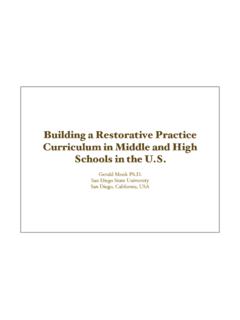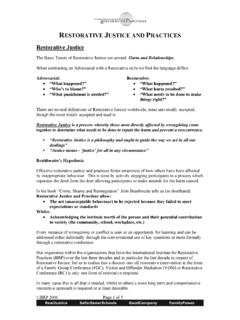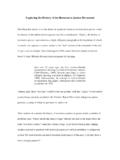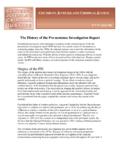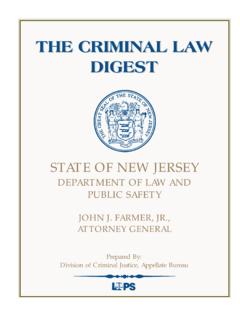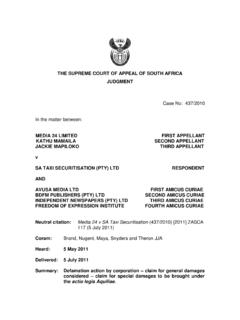Transcription of Justifying Restorative Justice: A Theoretical ...
1 Justifying Restorative justice : A Theoretical justification for the Use of Restorative justice Practices Zvi D. Gabbay It is no secret that the criminal justice system, society s means for responding to crime, is far from perfect. Crime victims often feel neglected and ignored by prosecutors and judges, the public does not perceive the system as just and fair, and the system s effectiveness in combating crime is questionable. Despite this reality, an alternative process has emerged, based on a new and entirely different paradigm of justice the Restorative justice paradigm. Empirical evidence sug-gests that Restorative processes, which empower crime victims, offenders and communities to take an active part in the formulation of the public response to crime, increase public trust in the justice system and may even reduce re-offense rates.
2 However, questions still remain as to whether employing such processes within the realm of criminal law can be justified and whether these processes con-flict with governing theories of punishment. This paper analyzes the premises of the two main theories of punishment that influence sentencing policies in most Western countries retributivism and utili-tarianism and compares them to the basic values that structure the Restorative justice theory. It then makes clear distinctions between Restorative justice and the rehabilitative ideal and addresses the criticism that, like rehabilitation, Restorative justice results in different punishments to equally culpable offenders.
3 The paper concludes that Restorative justice does not contradict retribution and utility as Theoretical justifications for penal sanctioning. Moreover, it suggests that restora-tive practices rehabilitate the basic notions of retribution and deterrence that have been neglected in modern sentencing schemes, that restorativism contributes new and deeper meaning to those notions and values, and that in doing so Restorative justice practices improve and promote society s response to crime. I. PREAMBLE It was a dry winter evening in January 2000. R., a young fighter pilot in the Israeli Air Force, was driving his car way home to one of the suburbs of Tel Aviv. Despite rush hour, traffic was moving smoothly, and R.
4 Was in no hurry. Sud-denly the brake lights of the car in front of him came on and the car quickly came to a full stop. R. hit the brakes and tried to steer the car aside to avoid colliding with the car in front of him. He was unable to stop and the passenger sitting in the _____ The writer is a former prosecutor for the Tel Aviv District Attorney s Office ( criminal Division) and is currently a doctorate (JSD) candidate at Columbia University School of Law. I am very grateful for the comments and contributions of John Braithwaite, George Fletcher, James Liebman, Jeffrey Fagan, Carol Liebman, and Robert Ferguson. I would also like to thank my mother, Shoshana, who tirelessly read through drafts of this article and my wife, Dafna, for her wisdom and encouragement.
5 350 JOURNAL OF DISPUTE RESOLUTION [Vol. 2 back seat of the car in front of him was killed instantly. The deceased was a mother on the way to her son s wedding. The driver of the car was her daughter. The police investigation determined that the car driving in front of R. slowed down and stopped due to heavy traffic and that the situation involved no unusual circumstances. If R. had paid more attention to the road ahead of him, he would have likely noticed the traffic delay and taken the necessary measures to avoid the accident. His negligence resulted in a fatal car crash. The evidence of his negligence precluded any course of action other than to charge R.]
6 With negligent homicide, an offense for which the maximum punish-ment is three years imprisonment. In the arraignment hearing, R. entered a not guilty plea, which launched a long and intense trial. After nearly two years, R. was convicted as charged, but due to his impeccable record, his duties and contri-bution to society, and the circumstances of the accident, he was sentenced to six months of community service in an old age home and precluded from holding a driver s license for a few years. For the prosecutor, defense attorney and judge who tried the case, there was nothing special about it. It was one of many fatal car accident cases which they were accustomed to handling.
7 The outcome of the trial was determined by professionals, dealing with complex questions of substantive criminal law, evidentiary rules and The final sentence well within the common range of sentencing for these types of cases was anticipated from the start. Ironically, even though the trial was controlled entirely by professionals, it was certainly not about them. It was the bereaved family, the deceased s friends and neighbors, R., and his family and close friends that were affected by the fatal accident. It was their lives that changed after the accident. Therefore, the ques-tion should be: How did the trial affect them? The short answer is not well.
8 At the end of the trial, the bereaved family was devastated. They did not under-stand why the trial took so long and could not accept its outcome. They were personally hurt by the fact the young pilot did not assume responsibility immedi-ately and lost all respect for the justice system that accepted this behavior. After close to two years of legal proceedings, the bereaved family and friends felt vic-timized again, this time by the justice system. Interestingly, R. s reaction to his trial was probably not very different. As he clearly articulated in his confident testimony in court, he truly did not feel responsible for the accident.
9 It is unlikely that he changed his mind after the conviction and probably perceived his convic-tion to be unjust. Although the facts of this case occurred in Israel and were tried according to Israeli law, it is representative of the methods employed by most common law criminal justice systems as their primary response to crime. However, this method suffers from three basic deficiencies, illustrated in this case: (1) the lack of a meaningful role for crime victims, (2) inefficiency and ineffectiveness, and (3) inability to be perceived as just and fair. After two years of legal proceedings, the decedent s family was victimized again by the justice system, the offender did not _____ 1.
10 See Susan M. Olson & Albert W. Dzur, Reconstructing Professional Roles in Restorative justice Programs, 2003 UTAH L. REV. 57 (examining the roles of professionals in the criminal justice system: the judge, prosecutor, defense attorney and probation officer in light of the growing popularity of Restorative justice practices). 2005] Justifying Restorative justice 351 learn anything he did not already know before the trial began, and both sides felt they were treated unjustly. In this article, I will first discuss these three deficiencies in detail, introduce the Restorative justice paradigm, offer a working definition for Restorative prac-tices and demonstrate their ability to successfully address the criminal justice system s deficiencies.



